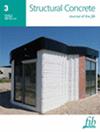采用新型滑动支撑的钢筋混凝土楼梯的抗震性能
IF 3.3
3区 工程技术
Q2 CONSTRUCTION & BUILDING TECHNOLOGY
引用次数: 0
摘要
在近年来的多次地震中,装配式楼梯和预制楼梯损坏严重。为避免楼梯失效,提出了新型滑动支撑楼梯,将半层楼板分为两部分,在楼梯梁和楼板之间设置滑动支撑。制作了带新型滑动支撑的楼梯缩小模型,并进行了反向循环加载试验,以研究其破坏模式、滞后行为、延性、刚度退化和能量耗散。试验结果表明,失效模式为框架支柱的挤压破坏,楼梯部件保持完好。新的滑动支架具有良好的工作性能,在拉力条件下,楼梯板与楼梯梁分离。此外,还建立了七个楼梯有限元模型来研究楼梯的抗震性能,并建立了七个框架结构有限元模型来研究楼梯对主体结构抗震性能的影响。楼梯的侧向刚度受普通楼梯的影响不对称,因此楼梯的扭转变形较大,而采用新型滑动支撑的楼梯对楼梯的侧向刚度没有影响。与框架结构相比,当考虑普通楼梯时,自然振动周期降低了约 5%,第一振型也改变了方向;当采用滑动支撑时,自然振动周期和第一振型没有变化。采用新的滑动支撑时,楼梯没有损坏,也没有影响主体结构的抗震性能。本文章由计算机程序翻译,如有差异,请以英文原文为准。
Seismic performance of reinforced concrete stairs with new sliding support
Cast‐in‐suit stairs and precast stairs were damaged seriously during many earthquakes in recent years. Stairs with new sliding support were put forward in order to avoid the failure of stairs, landing slab in the half floor was divided into two parts and sliding support was placed between stair beam and landing slab. Down‐scaled model of stairs with new sliding support was produced, and reversed cyclic loading test was conducted to investigate the failure mode, hysteretic behavior, ductility, stiffness degradation and energy dissipation. The failure mode was crushing damage of frame column and stair components remained intact. The new sliding support had good working properties and landing slab separated from stair beam under the pull condition. In addition, seven finite element models of staircase were developed to investigate the seismic performance of staircase, and seven finite element models of frame structure were developed to investigate the effect of stairs on the seismic performance of main structure. Lateral stiffness of the staircase was asymmetrical affected by common stairs, so torsional deformation of staircase was large, and stairs with new sliding support had no effect to the lateral stiffness of staircase. Compared with frame structure, the natural period of vibration decreased approximately by 5% and the first vibration mode also changed direction when common stairs was considered, the natural period of vibration and the first vibration mode were not change when sliding support was adopted. Stairs were not damaged and did not affect the seismic performance of main structure when new sliding support was used.
求助全文
通过发布文献求助,成功后即可免费获取论文全文。
去求助
来源期刊

Structural Concrete
CONSTRUCTION & BUILDING TECHNOLOGY-ENGINEERING, CIVIL
CiteScore
5.60
自引率
15.60%
发文量
284
审稿时长
3 months
期刊介绍:
Structural Concrete, the official journal of the fib, provides conceptual and procedural guidance in the field of concrete construction, and features peer-reviewed papers, keynote research and industry news covering all aspects of the design, construction, performance in service and demolition of concrete structures.
Main topics:
design, construction, performance in service, conservation (assessment, maintenance, strengthening) and demolition of concrete structures
research about the behaviour of concrete structures
development of design methods
fib Model Code
sustainability of concrete structures.
 求助内容:
求助内容: 应助结果提醒方式:
应助结果提醒方式:


